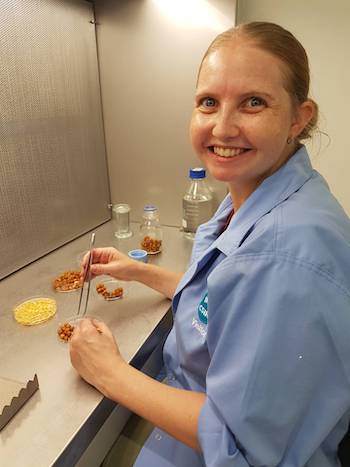Key points
- The genes involved in chickpea stress responses are being examined
- Understanding these gene families could lead to energy conservation
- This saved energy could be diverted to plant growth
- Pre-breeding material could be available in two to three years.
A better understanding of the genes involved in chickpea respiration, nitrogen transport and their environmental stress responses could help lead to varieties with improved growth.
Flinders University’s Dr Crystal Sweetman says the pioneering work is a balancing act. “We want to ensure that chickpeas contain adequate stress-response pathways; however, reducing some could maximise plant growth,” she says.
The work is part of the GRDC co-invested Australian Research Council (ARC) Legumes for Sustainable Agriculture (LSA) Industrial Transformation Hub, which winds up this year. Dr Sweetman’s project falls under the overall chickpea transformation project led by Professor David Day.
Dr Sweetman says the gene family being examined in her work is called the alternative oxidase (AOX) gene family. It is involved in mitochondrial alternative respiration. “It is a pathway that is absent in higher animals but vitally important in the response of plants to environmental stress.”
 Flinders University researcher Dr Crystal Sweetman. Photo: Supplied
Flinders University researcher Dr Crystal Sweetman. Photo: Supplied
She says the pathway can be thought of as a valve: “It diverts energy from primary metabolic pathways towards antioxidant activities that promote resilience during stress. However, this comes potentially at the cost of considerable amounts of energy that could otherwise be used for growth when the plant is not under stress.”
For example, her work has already found at least one gene within the AOX family that is expressed all the time in chickpeas and other legumes. Another identified is stress responsive.
The gene that is expressed all the time is normally turned on only in times of environmental stress in non-legume plants. “Being active all the time in legumes is potentially wasteful in terms of energy use. We could instead divert that energy to plant growth if we could regulate AOX gene expression.
“We want to know: can we manipulate that overly active gene and make the plant more productive? We have measured respiration in chickpea leaves and found that 25 per cent of this can occur via the AOX pathway.
"Changing that could be significant for growth.”
Although this early work shows there could be significant room for improvement, a balance is needed. “We don’t want to obliterate this pathway completely because it helps the plant cope with stress. It’s a balancing act and that is why we are also interested in the regulation of the genes. Can we change the tissues in which the genes are expressed? Can we remove that gene while retaining or even enhancing the stress-responsive gene to improve growth and productivity without impairing the plant’s stress response systems?”
The chickpea transformation method being used to address some of these questions was developed by Professor TJ Higgins’ group at CSIRO Black Mountain. “We were lucky to be able to visit TJ’s lab in early 2019 before the impacts of COVID-19. Since then, we have successfully taken the tissue culture method from the lab all the way through to non-transgenic plants in soil. Now we can begin using this tissue culture method to introduce our genetic modifications that is expected to provide some answers to the above.”
Dr Sweetman’s work with AOX is one of two current projects involving the chickpea transformation method at Flinders University. The second examines nitrogen transport.
Nitrogen transport
Professor Day says very little is known about how nitrogen is transported from the nitrogen-fixing bacteria in chickpea nodules to the plant.
An important process common to legumes, nitrogen fixation enables the plants to flourish on minimal fertiliser inputs, improves the soil microflora profile and nitrogen content, while reducing costs and potential waterway contamination.
There are two major groups of nitrogen transport compounds that can be released from the nodules of legume plants – ureides and amides – and typically a particular legume will favour one over the other. However, there are reports that chickpeas transport both forms of nitrogen.
PhD student Troy Miller is investigating which nitrogen transport compounds chickpeas use, how they respond to environmental stress and which transporter gene or genes are responsible for the majority of nitrogen transport around the plant.

PhD student Troy Miller is studying how nitrogen moves around chickpeas. Photo: Supplied
By knocking out one or more gene candidates and testing for pools of nitrogen throughout the plant, Professor Day says, the relative importance of specific transporters in chickpea can be determined.
He says the work is novel because these pathways have not been characterised before in chickpeas. In other legumes such as soybeans, researchers in the US have shown that manipulating these transporters can improve symbiotic nitrogen fixation and enhance plant growth and yield.
“We aim to find the transporters in chickpeas and manipulate them to enhance growth of this important pulse crop,” he says.
More information: Crystal Sweetman, crystal.sweetman@flinders.edu.au; David Day, 08 8201 5205, david.day@flinders.edu.au

























































